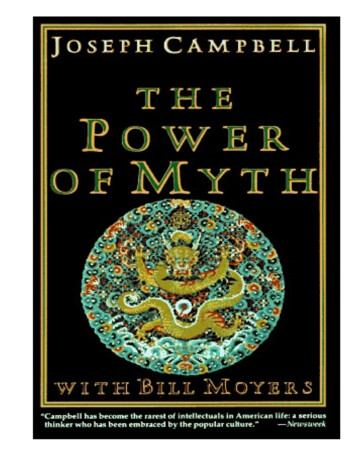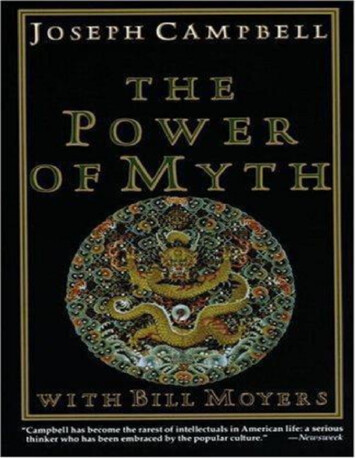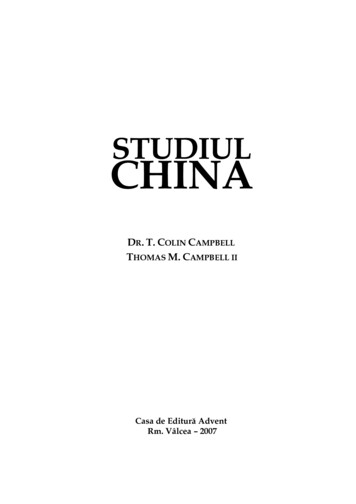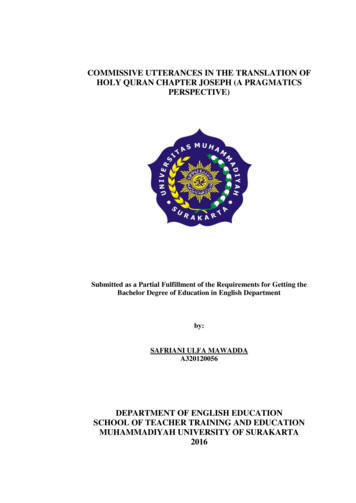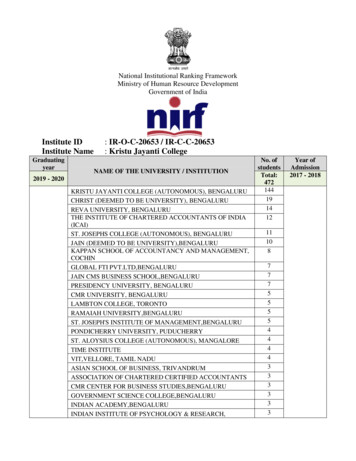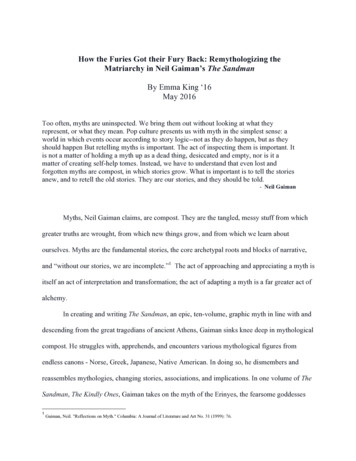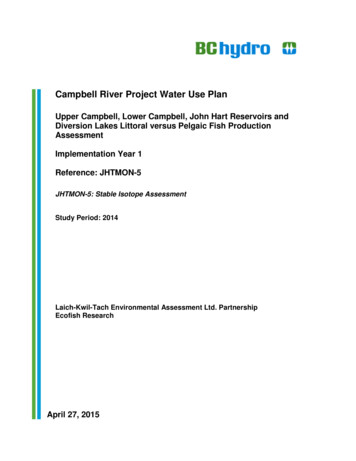
Transcription
The Power of Myth (Anchor Edition, 1991) by Joseph Campbell with Bill Moyers a.b.ebook v3.0 / Notes at EOF
FIRST ANCHOR BOOKS EDITION, JULY 1991 Copyright 1988 by ApostropheSProductions, Inc., and Alfred van der Marck EditionsAll rights reserved under International and Pan-American Copyright Conventions.Published in the United States by Anchor Books, a division of Random House, Inc., NewYork, and simultaneously in Canada by Random House of Canada Limited, Toronto.The fully illustrated edition of The Power of Myth was originally published in bothhardcover and paperback by Doubleday in 1988. The Anchor Books edition is publishedby arrangement with Doubleday.ANCHOR BOOKS and colophon are registered trademarks of Random House, Inc.Grateful acknowledgment is made to Barnes & Noble Books, Totowa, New Jersey, forpermission to quote from "The Second Coming" by William Butler Yeats.Campbell, Joseph, 1904- The power of myth / Joseph Campbell, with Bill Moyers; BettySue Flowers, editor. -- 1st Anchor Books ed. p. cm. 1. Myth. 2. Campbell, Joseph, 1904-- Interviews. 3. Religion historians -- United States -- Interviews. I. Moyers, Bill D. II.Flowers, Betty S. III. Title.[BL304.C36 1990] 90-23860 291.1'3 -- dc20 CIPISBN 0-385-41886-8www.anchorbooks.comPRINTED IN THE UNITED STATES OF AMERICA26 25 24 23 2221 20 19 18To Judith, who has long heard the musicContents Editor's Note Introduction by Bill Moyers I Myth and the Modern World IIThe Journey Inward III The First Storytellers IV Sacrifice and Bliss V The Hero'sAdventure VI The Gift of the Goddess VII Tales of Love and Marriage VIII Masks ofEternityEditor's NoteThis conversation between Bill Moyers and Joseph Campbell took place in 1985 and1986 at George Lucas' Skywalker Ranch and later at the Museum of Natural History inNew York. Many of us who read the original transcripts were struck by the richabundance of material captured during the twenty-four hours of filming -- much ofwhich had to be cut in making the six-hour PBS series. The idea for a book arose fromthe desire to make this material available not only to viewers of the series but also tothose who have long appreciated Campbell through reading his books.
In editing this book, I attempted to be faithful to the flow of the original conversationwhile at the same time taking advantage of the opportunity to weave in additionalmaterial on the topic from wherever it appeared in the transcripts. When I could, Ifollowed the format of the TV series. But the book has its own shape and spirit and isdesigned to be a companion to the series, not a replica of it. The book exists, in part,because this is a conversation of ideas worth pondering as well as watching.On a more profound level, of course, the book exists because Bill Moyers was willing toaddress the fundamental and difficult subject of myth -- and because Joseph Campbellwas willing to answer Moyers' penetrating questions with self-revealing honesty, basedon a lifetime of living with myth. I am grateful to both of them for the opportunity towitness this encounter, and to Jacqueline Kennedy Onassis, the Doubleday editor,whose interest in the ideas of Joseph Campbell was the prime mover in the publicationof this book. I am grateful, also, to Karen Bordelon, Alice Fisher, Lynn Cohea, SonyaHaddad, Joan Konner, and John Flowers for their support, and especially to MaggieKeeshen for her many retypings of the manuscript and for her keen editorial eye. Forhelp with the manuscript, I am grateful to Judy Doctoroff, Andie Tucher, BeckyBerman, and Judy Sandman. The major task of illustration research was done by VeraAronow, Lynn Novick, Elizabeth Fischer, and Sabra Moore, with help from AnnmariRonnberg. Both Bill Moyers and Joseph Campbell read the manuscript and offeredmany helpful suggestions -- but I am grateful that they resisted the emptation to rewritetheir words into book talk. Instead, they let the conversation itself live on the page. -BETTY SUE FLOWERS University of Texas at AustinIntroductionFor weeks after Joseph Campbell died, I was reminded of him just about everywhere Iturned.Coming up from the subway at Times Square and feeling the energy of the pressingcrowd, I smiled to myself upon remembering the image that once had appeared toCampbell there: "The latest incarnation of Oedipus, the continued romance of Beautyand the Beast, stands this afternoon on the corner of Forty-second Street and FifthAvenue, waiting for the traffic light to change."At a preview of John Huston's last film, The Dead,based on a story by James Joyce, Ithought again of Campbell. One of his first important works was a key to FinnegansWake. What Joyce called "the grave and constant" in human sufferings Campbell knewto be a principal theme of classic mythology. "The secret cause of all suffering," he said,"is mortality itself, which is the prime condition of life. It cannot be denied if life is to beaffirmed."Once, as we were discussing the subject of suffering, he mentioned in tandem Joyce andIgjugarjuk. "Who is Igjugarjuk?" I said, barely able to imitate the pronunciation."Oh," replied Campbell, "he was the shaman of a Caribou Eskimo tribe in northernCanada, the one who told European visitors that the only true wisdom 'lives far from
mankind, out in the great loneliness, and can be reached only through suffering.Privation and suffering alone open the mind to all that is hidden to others.' ""Of course," I said, "Igjugarjuk."Joe let pass my cultural ignorance. We had stopped walking. His eyes were alight as hesaid, "Can you imagine a long evening around the fire with Joyce and Igjugarjuk? Boy,I'd like to sit in on that."Campbell died just before the twenty-fourth anniversary of John F. Kennedy'sassassination, a tragedy he had discussed in mythological terms during our first meetingyears earlier. Now, as that melancholy remembrance came around again, I sat talkingwith my grown children about Campbell's reflections. The solemn state funeral he haddescribed as "an illustration of the high service of ritual to a society," evokingmythological themes rooted in human need. "This was a ritualized occasion of thegreatest social necessity," Campbell had written. The public murder of a president,"representing our whole society, the living social organism of which ourselves were themembers, taken away at a moment of exuberant life, required a compensatory rite toreestablish the sense of solidarity. Here was an enormous nation, made those four daysinto a unanimous community, all of us participating in the same way, simultaneously, ina single symbolic event." He said it was "the first and only thing of its kind in peacetimethat has ever given me the sense of being a member of this whole national community,engaged as a unit in the observance of a deeply significant rite."That description I recalled also when one of my colleagues had been asked by a friendabout our collaboration with Campbell: "Why do you need the mythology?" She heldthe familiar, modern opinion that "all these Greek gods and stuff" are irrelevant to thehuman condition today. What she did not know -- what most do not know -- is that theremnants of all that "stuff" line the walls of our interior system of belief, like shards ofbroken pottery in an archaeological site. But as we are organic beings, there is energy inall that "stuff." Rituals evoke it. Consider the position of judges in our society, whichCampbell saw in mythological, not sociological, terms. If this position were just a role,the judge could wear a gray suit to court instead of the magisterial black robe. For thelaw to hold authority beyond mere coercion, the power of the judge must be ritualized,mythologized. So must much of life today, Campbell said, from religion and war to loveand death.Walking to work one morning after Campbell's death, I stopped before a neighborhoodvideo store that was showing scenes from George Lucas' Star Wars on a monitor in thewindow. I stood there thinking of the time Campbell and I had watched the movietogether at Lucas' Skywalker Ranch in California. Lucas and Campbell had becomegood friends after the filmmaker, acknowledging a debt to Campbell's work, invited thescholar to view the Star Warstrilogy. Campbell reveled in the ancient themes and motifsof mythology unfolding on the wide screen in powerful contemporary images. On thisparticular visit, having again exulted over the perils and heroics of Luke Skywalker, Joegrew animated as he talked about how Lucas "has put the newest and most powerful
spin" to the classic story of the hero."And what is that?" I asked."It's what Goethe said in Faust but which Lucas has dressed in modern idiom -- themessage that technology is not going to save us. Our computers, our tools, our machinesare not enough. We have to rely on our intuition, our true being.""Isn't that an affront to reason?" I said. "And aren't we already beating a hasty retreatfrom reason, as it is?""That's not what the hero's journey is about. It's not to deny reason. To the contrary,by overcoming the dark passions, the hero symbolizes our ability to control theirrational savage within us." Campbell had lamented on other occasions our failure "toadmit within ourselves the carnivorous, lecherous fever" that is endemic to humannature. Now he was describing the hero's journey not as a courageous act but as a lifelived in self-discovery, "and Luke Skywalker was never more rational than when hefound within himself the resources of character to meet his destiny."Ironically, to Campbell the end of the hero's journey is not the aggrandizement of thehero. "It is," he said in one of his lectures, "not to identify oneself with any of thefigures or powers experienced. The Indian yogi, striving for release, identifies himselfwith the Light and never returns. But no one with a will to the service of others wouldpermit himself such an escape. The ultimate aim of the quest must be neither releasenor ecstasy for oneself, but the wisdom and the power to serve others." One of the manydistinctions between the celebrity and the hero, he said, is that one lives only for selfwhile the other acts to redeem society.Joseph Campbell affirmed life as adventure. "To hell with it," he said, after hisuniversity adviser tried to hold him to a narrow academic curriculum. He gave up onthe pursuit of a doctorate and went instead into the woods to read. He continued all hislife to read books about the world: anthropology, biology, philosophy, art, history,religion. And he continued to remind others that one sure path into the world runsalong the printed page. A few days after his death, I received a letter from one of hisformer students who now helps to edit a major magazine. Hearing of the series on whichI had been working with Campbell, she wrote to share how this man's "cyclone ofenergy blew across all the intellectual possibilities" of the students who sat "breathlessin his classroom" at Sarah Lawrence College. "While all of us listened spellbound," shewrote, "we did stagger under the weight of his weekly reading assignments. Finally, oneof our number stood up and confronted him (Sarah Lawrence style), saying: 'I amtaking three other courses, you know. All of them assigned reading, you know. How doyou expect me to complete all this in a week?' Campbell just laughed and said, 'I'mastonished you tried. You have the rest of your life to do the reading.' "She concluded, "And I still haven't finished -- the never ending example of his life andwork."
One could get a sense of that impact at the memorial service held for him at theMuseum of Natural History in New York. Brought there as a boy, he had beentransfixed by the totem poles and masks. Who made them? he wondered. What did theymean? He began to read everything he could about Indians, their myths and legends. Byten he was into the pursuit that made him one of the world's leading scholars ofmythology and one of the most exciting teachers of our time; it was said that "he couldmake the bones of folklore and anthropology live." Now, at the memorial service in themuseum where three quarters of a century earlier his imagination had first beenexcited, people gathered to pay honor to his memory. There was a performance byMickey Hart, the drummer for the Grateful Dead, the rock group with whom Campbellshared a fascination with percussion. Robert Bly played a dulcimer and read poetrydedicated to Campbell. Former students spoke, as did friends whom he had made afterhe retired and moved with his wife, the dancer Jean Erdman, to Hawaii. The greatpublishing houses of New York were represented. So were writers and scholars, youngand old, who had found their pathbreaker in Joseph Campbell.And journalists. I had been drawn to him eight years earlier when, self-appointed, I wasattempting to bring to television the lively minds of our time. We had taped twoprograms at the museum, and so compellingly had his presence permeated the screenthat more than fourteen thousand people wrote asking for transcripts of theconversations. I vowed then that I would come after him again, this time for a moresystematic and thorough exploration of his ideas. He wrote or edited some twenty books,but it was as a teacher that I had experienced him, one rich in the lore of the world andthe imagery of language, and I wanted others to experience him as teacher, too. So thedesire to share the treasure of the man inspired my PBS series and this book.A journalist, it is said, enjoys a license to be educated in public; we are the lucky ones,allowed to spend our days in a continuing course of adult education. No one has taughtme more of late than Campbell, and when I told him he would have to bear theresponsibility for whatever comes of having me as a pupil, he laughed and quoted an oldRoman: "The fates lead him who will; him who won't they drag."He taught, as great teachers teach, by example. It was not his manner to try to talkanyone into anything (except once, when he persuaded Jean to marry him). Preacherserr, he told me, by trying "to talk people into belief; better they reveal the radiance oftheir own discovery." How he did reveal a joy for learning and living! Matthew Arnoldbelieved the highest criticism is "to know the best that is known and thought in theworld, and by in its turn making this known, to create a current of true and freshideas." This is what Campbell did. It was impossible to listen to him -- truly to hear him-- without realizing in one's own consciousness a stirring of fresh life, the rising of one'sown imagination.He agreed that the "guiding idea" of his work was to find "the commonality of themesin world myths, pointing to a constant requirement in the human psyche for a centeringin terms of deep principles."
"You're talking about a search for the meaning of life?" I asked."No, no, no," he said. "For the experienceof being alive."I have said that mythology is an interior road map of experience, drawn by people whohave traveled it. He would, I suspect, not settle for the journalist's prosaic definition. Tohim mythology was "the song of the universe," "the music of the spheres" -- music wedance to even when we cannot name the tune. We are hearing its refrains "whether welisten with aloof amusement to the mumbo jumbo of some witch doctor of the Congo, orread with cultivated rapture translations from sonnets of Lao-tsu, or now and againcrack the hard nutshell of an argument of Aquinas, or catch suddenly the shiningmeaning of a bizarre Eskimoan fairy tale."He imagined that this grand and cacophonous chorus began when our primal ancestorstold stories to themselves about the animals that they killed for food and about thesupernatural world to which the animals seemed to go when they died. "Out theresomewhere," beyond the visible plain of existence, was the "animal master," who heldover human beings the power of life and death: if he failed to send the beasts back to besacrificed again, the hunters and their kin would starve. Thus early societies learnedthat "the essence of life is that it lives by killing and eating; that's the great mystery thatthe myths have to deal with." The hunt became a ritual of sacrifice, and the hunters inturn performed acts of atonement to the departed spirits of the animals, hoping to coaxthem into returning to be sacrificed again. The beasts were seen as envoys from thatother world, and Campbell surmised "a magical, wonderful accord" growing betweenthe hunter and the hunted, as if they were locked in a "mystical, timeless" cycle ofdeath, burial, and resurrection. Their art -- the paintings on cave walls -- and oralliterature gave form to the impulse we now call religion.As these primal folk turned from hunting to planting, the stories they told to interpretthe mysteries of life changed, too. Now the seed became the magic symbol of the endlesscycle. The plant died, and was buried, and its seed was born again. Campbell wasfascinated by how this symbol was seized upon by the world's great religions as therevelation of eternal truth -- that from death comes life, or as he put it: "From sacrifice,bliss.""Jesus had the eye," he said. "What a magnificent reality he saw in the mustard seed."He would quote the words of Jesus from the gospel of John -- "Truly, truly, I say untoyou, unless a grain of wheat falls into the earth and dies, it remains alone; but if it dies,it bears much fruit" -- and in the next breath, the Koran: "Do you think that you shallenter the Garden of Bliss without such trials as came to those who passed away beforeyou?" He roamed this vast literature of the spirit, even translating the Hindu scripturesfrom Sanskrit, and continued to collect more recent stories which he added to thewisdom of the ancients. One story he especially liked told of the troubled woman whocame to the Indian saint and sage Ramakrishna, saying, "O Master, I do not find that Ilove God." And he asked, "Is there nothing, then, that you love?" To this she answered,"My little nephew." And he said to her, "There is your love and service to God, in your
love and service to that child.""And there," said Campbell, "is the high message of religion: 'Inasmuch as ye havedone it unto one of the least of these. . .' "A spiritual man, he found in the literature of faith those principles common to thehuman spirit. But they had to be liberated from tribal lien, or the religions of the worldwould remain -- as in the Middle East and Northern Ireland today -- the source ofdisdain and aggression. The images of God are many, he said, calling them "the masksof eternity" that both cover and reveal "the Face of Glory." He wanted to know what itmeans that God assumes such different masks in different cultures, yet how it is thatcomparable stories can be found in these divergent traditions -- stories of creation, ofvirgin births, incarnations, death and resurrection, second comings, and judgment days.He liked the insight of the Hindu scripture: "Truth is one; the sages call it by manynames." All our names and images for God are masks, he said, signifying the ultimatereality that by definition transcends language and art. A myth is a mask of God, too -- ametaphor for what lies behind the visible world. However the mystic traditions differ,he said, they are in accord in calling us to a deeper awareness of the very act of livingitself. The unpardonable sin, in Campbell's book, was the sin of inadvertence, of notbeing alert, not quite awake.I never met anyone who could better tell a story. Listening to him talk of primalsocieties, I was transported to the wide plains under the great dome of the open sky, orto the forest dense, beneath a canopy of trees, and I began to understand how the voicesof the gods spoke from the wind and thunder, and the spirit of God flowed in everymountain stream, and the whole earth bloomed as a sacred place -- the realm of mythicimagination. And I asked: Now that we moderns have stripped the earth of its mystery-- have made, in Saul Bellow's description, "a housecleaning of belief" -- how are ourimaginations to be nourished? By Hollywood and made-for-TV movies?Campbell was no pessimist. He believed there is a "point of wisdom beyond the conflictsof illusion and truth by which lives can be put back together again." Finding it is the"prime question of the time." In his final years he was striving for a new synthesis ofscience and spirit. "The shift from a geocentric to a heliocentric world view," he wroteafter the astronauts touched the moon, "seemed to have removed man from the center -and the center seemed so important. Spiritually, however, the center is where sight is.Stand on a height and view the horizon. Stand on the moon and view the whole earthrising -- even, by way of television, in your parlor." The result is an unprecedentedexpansion of horizon, one that could well serve in our age, as the ancient mythologiesdid in theirs, to cleanse the doors of perception "to the wonder, at once terrible andfascinating, of ourselves and of the universe." He argued that it is not science that hasdiminished human beings or divorced us from divinity. On the contrary, the newdiscoveries of science "rejoin us to the ancients" by enabling us to recognize in thiswhole universe "a reflection magnified of our own most inward nature; so that we areindeed its ears, its eyes, its thinking, and its speech -- or, in theological terms, God'sears, God's eyes, God's thinking, and God's Word." The last time I saw him I asked him
if he still believed -- as he once had written -- "that we are at this moment participatingin one of the very greatest leaps of the human spirit to a knowledge not only of outsidenature but also of our own deep inward mystery."He thought a minute and answered, "The greatest ever."When I heard the news of his death, I tarried awhile in the copy he had given me of TheHero with a Thousand Faces.And I thought of the time I first discovered the world ofthe mythic hero. I had wandered into the little public library of the town where I grewup and, casually exploring the stacks, pulled down a book that opened wonders to me:Prometheus, stealing fire from the gods for the sake of the human race; Jason, bravingthe dragon to seize the Golden Fleece; the Knights of the Round Table, pursuing theHoly Grail. But not until I met Joseph Campbell did I understand that the Westerns Isaw at the Saturday matinees had borrowed freely from those ancient tales. And thatthe stories we learned in Sunday school corresponded with those of other cultures thatrecognized the soul's high adventure, the quest of mortals to grasp the reality of God.He helped me to see the connections, to understand how the pieces fit, and not merely tofear less but to welcome what he described as "a mighty multicultural future."He was, of course, criticized for dwelling on the psychological interpretation of myth,for seeming to confine the contemporary role of myth to either an ideological or atherapeutic function. I am not competent to enter that debate, and leave it for others towage. He never seemed bothered by the controversy. He just kept on teaching, openingothers to a new way of seeing.It was, above all, the authentic life he lived that instructs us. When he said that mythsare clues to our deepest spiritual potential, able to lead us to delight, illumination, andeven rapture, he spoke as one who had been to the places he was inviting others to visit.What did draw me to him?Wisdom, yes; he was very wise.And learning; he did indeed "know the vast sweep of our panoramic past as few menhave ever known it." But there was more. A story's the way to tell it. He was a man witha thousand stories. This was one of hisfavorites. In Japan for an international conference on religion, Campbell overheardanother American delegate, a social philosopher from New York, say to a Shinto priest,"We've been now to a good many ceremonies and have seen quite a few of your shrines.But I don't get your ideology. I don't get your theology." The Japanese paused asthough in deep thought and then slowly shook his head. "I think we don't haveideology," he said. "We don't have theology. We dance."And so did Joseph Campbell -- to the music of the spheres.
-- BILL MOYERSI MYTH AND THE MODERN WORLDPeople say that what we're all seeking is a meaning for life. 1 don't think that's whatwe're really seeking. I think that what we're seeking is an experience of being alive, sothat our life experiences on the purely physical plane will have resonances within ourown innermost being and reality, so that we actually feel the rapture of being alive.MOYERS: Why myths? Why should we careabout myths? What do they have to dowith my life?CAMPBELL: My first response would be, "Go on, live your life, it's a good life -- youdon't need mythology." I don't believe in being interested in a subject just because it'ssaid to be important. I believe in being caught by it somehow or other. But you may findthat, with a proper introduction, mythology will catch you. And so, what can it do foryou if it does catch you?One of our problems today is that we are not well acquainted with the literature of thespirit. We're interested in the news of the day and the problems of the hour. It used tobe that the university campus was a kind of hermetically sealed-off area where the newsof the day did not impinge upon your attention to the inner life and to the magnificenthuman heritage we have in our great tradition -- Plato, Confucius, the Buddha, Goethe,and others who speak of the eternal values that have to do with the centering of ourlives. When you get to be older, and the concerns of the day have all been attended to,and you turn to the inner life -- well, if you don't know where it is or what it is, you'll besorry.Greek and Latin and biblical literature used to be part of everyone's education. Now,when these were dropped, a whole tradition of Occidental mythological information waslost. It used to be that these stories were in the minds of people. When the story is inyour mind, then you see its relevance to something happening in your own life. It givesyou perspective on what's happening to you. With the loss of that, we've really lostsomething because we don't have a comparable literature to take its place. These bits ofinformation from ancient times, which have to do with the themes that have supportedhuman life, built civilizations, and informed religions over the millennia, have to do withdeep inner problems, inner mysteries, inner thresholds of passage, and if you don'tknow what the guide-signs are along the way, you have to work it out yourself. But oncethis subject catches you, there is such a feeling, from one or another of these traditions,of information of a deep, rich, life-vivifying sort that you don't want to give it up.MOYERS: So we tell stories to try to come to terms with the world, to harmonize ourlives with reality?CAMPBELL: I think so, yes. Novels -- great novels -- can be wonderfully instructive.
In my twenties and thirties and even on into my forties, James Joyce and Thomas Mannwere my teachers. I read everything they wrote. Both were writing in terms of whatmight be called the mythological traditions. Take, for example, the story of Tonio, inThomas Mann's Tonio Kröger.Tonio's father was a substantial businessman, a majorcitizen in his hometown. Little Tonio, however, had an artistic temperament, so hemoved to Munich and joined a group of literary people who felt themselves above themere money earners and family men.So here is Tonio between two poles: his father, who was a good father, responsible andall of that, but who never did the thing he wanted to in all his life -- and, on the otherhand, the one who leaves his hometown and becomes a critic of that kind of life. ButTonio found that he really loved these hometown people. And although he thoughthimself a little superior in an intellectual way to them and could describe them withcutting words, his heart was nevertheless with them.But when he left to live with the bohemians, he found that they were so disdainful of lifethat he couldn't stay with them, either. So he left them, and wrote a letter back tosomeone in the group, saying, "I admire those cold, proud beings who adventure uponthe paths of great and daemonic beauty and despise 'mankind'; but I do not envy them.For if anything is capable of making a poet of a literary man, it is my hometown love ofthe human, the living and ordinary. All warmth derives from this love, all kindness andall humor. Indeed, to me it even seems that this must be that love of which it is writtenthat one may 'speak with the tongues of men and of angels,' and yet, lacking love, be 'assounding brass or a tinkling cymbal.' "And then he says, "The writer must be true to truth." And that's a killer, because theonly way you can describe a human being truly is by describing his imperfections. Theperfect human being is uninteresting -- the Buddha who leaves the world, you know. Itis the imperfections of life that are lovable. And when the writer sends a dart of the trueword, it hurts. But it goes with love. This is what Mann called "erotic irony," the lovefor that which you are killing with your cruel, analytical word.MOYERS: I cherish that image: my hometown love, the feeling you get for that place,no matter how long you've been away or even if you never return. That was where youfirst discovered people. But why do you say you love people for their imperfections? .CAMPBELL: Aren't children lovable because they're falling down all the time andhave little bodies with the heads too big? Didn't Walt Disney know all about this whenhe did the seven dwarfs? And these funny little dogs that people have -- they're lovablebecause they're so imperfect.MOYERS: Perfection would be a bore, wouldn't it?CAMPBELL: It would have to be. It would be inhuman. The umbilical point, thehumanity, the thing that makes you human and not supernatur
law to hold authority beyond mere coercion, the power of the judge must be ritualized, mythologized. So must much of life today, Campbell said, from religion and war to love and death. Walking to work one morning after Campbell's death, I stopped before a neighborhood video store that was showing scenes from George Lucas' Star Wars on a monitor in the



